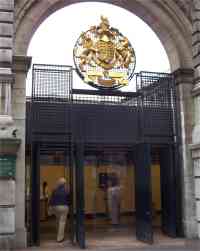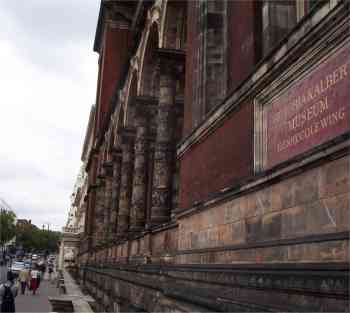London Museums - The Victoria and Albert Museum
Here we have a short description with photos of the V&A. This London museum houses one of the world's most important collections of decorative art and fine art. It is named after Queen Victoria, queen of England from 1837 to 1901, and her husband, Prince Albert.
Opening times Daily 9.30am-6pm
|
Victoria and Albert Museum
The museum's collections originated from works purchased during the Great Exhibition of 1851, a world's fair held in London. It was founded in 1852 as a manufacturing museum to motivate and showcase British manufacturing. It was moved to South Kensington in 1857 and was renamed Victoria and Albert in 1899. In 1890, the government decided that the museum's premises should be expanded, but construction did not start until 1899, when Queen Victoria laid the foundation stone in what would be her last public appearance. The permanent museum building was completed in 1909. The principal designer was the English architect Sir Aston Webb who was the winner of the 1890 competition to choose a design. Its galleries contain over four million objects spanning some 3500 years of human creativity in the field of decorative arts. It is spread over 11 acres and is home to many national collections. Many of items are on loan to companies and organizations in the United Kingdom and the rest of the world. One of its primary uses was for education as it had casts of many important pieces of art, such as Michelangelo's David, the Portico de la Gloria from Santiago de la Compostela and of Trajan's Column. In 1879-80, the museum acquired the collection of the East India Company's India Museum, and these pieces are now in the Oriental galleries. The museum has undergone many changes in how its exhibits were displayed. It was at first organized around the materials such as ceramics, woodwork, metalwork, textiles and sculpture but this was confusing as it was mixing periods and styles. It then moved to a clearer materials-based display in 1909 when more space was provided in the expansion of the museum's buildings. It remained so for 40 years when it moved to an aesthetic and historical presentation where objects of different mediums were placed together but were of the same period and style. After the end of the Second World War, this move was in the form of creating two types of galleries, firstly Primary Galleries containing displays by style, period or nationality, and then Secondary Galleries retaining materials-based displays. Recently, the division is now between Materials and Techniques Galleries focusing on the production of objects and Art and Design Galleries examining the uses of objects within the cultures from they came from. The Victoria and Albert Museum displays many masterpieces of fine art, including an important collection of the works of the English painter John Constable. The museum is also the home of the National Art Library. It differs from the British museum in the sense that the great majority of its pieces and collections were purchased with government funds, although there are important private bequests such as the Jones ones in 1882 and Salting in 1909 respectively. For further information on the Victoria and Albert Museum click here |


